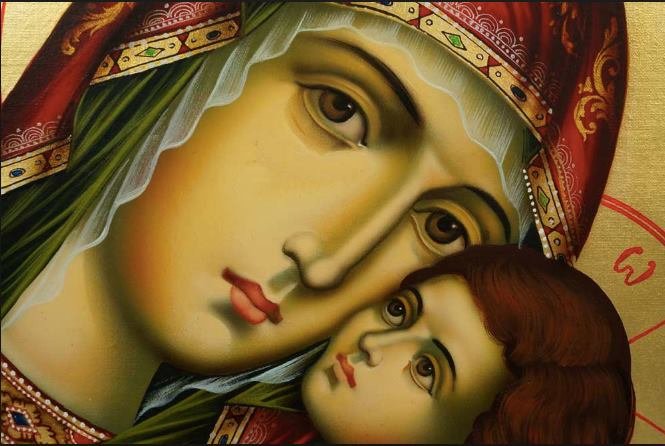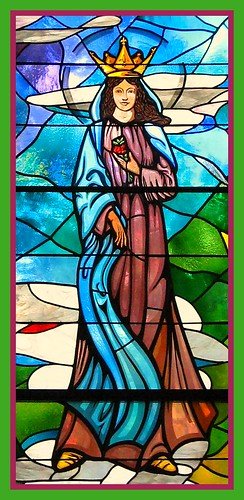Icons and Mary: that’s the phrase—the two main objections, constantly named by those inquiring into the Orthodox Church.
I covered icons in my previous article. Today, I will discuss Mary, hereafter referred to generally as Theotokos (“Mother of God”), the Church’s preferred way to address her.
Here are five points to help those on the cusp to get past the objections with the Theotokos.
1. “One Mediator between God and man” is retained in Orthodoxy.
Regarding the Theotokos, I will spend the majority of this article painting a positive picture, whetting the imagination, since in certain cases honey is more effective than its opposite. But first I will address the main reason Protestants bristle at the mention of the Theotokos (I did!)—they are concerned that she is stealing part of the role that is exclusively reserved for Christ, who is the “one mediator between God and man, the man Jesus Christ” (I Tim 2:5). Quick points:
One Mediator
If by mediator, you mean someone to be worshipped, the Orthodox Church does not believe the Theotokos should be worshipped. That is reserved for the Father, Son, and Holy Spirit. She is to be venerated (adored, honored). In our services the Trinity is worshipped and “glorified.” That word is not used for the Theotokos, who is venerated and “magnified.” (See my previous article on icons for discussion on how in an Asian-Eastern culture—and Orthodoxy is eastern—even businessmen today bow down to show respect, not worship.)
The Theotokos, while not the theology proper one mediator between God and man, is given so much appreciation in the Church because she played such a key role in providing human nature for the man who became THE mediator. (Admittedly, Mariolatry does exist in certain places in Catholicism, but not officially.)
Don’t freak out about mediation. Did someone lead you to Christ? Did your grandmother pray for you to find the Lord? Did a beloved pastor play a crucial role in your relationship with Christ? Did a Gideon plant a bible for you? All of these played a mediating role. And, of course, they did not take away from the theological fact that Christ is our one mediator between God and man.
2. The Orthodox world better reflects a population over 50 percent female.
Now the positive.
A woman is center stage! C’mon now. Think about it. Our western culture is screaming for more of the feminine. Clearly, it is an over-reaction, but why? I would venture to say because our form of Christianity is bereft of feminine representation. The way to do this is not female clergy. (The Orthodox church won’t even allow women behind the altar, so don’t think the Church’s solution is modernism.) The solution is venerating and adoring women, the same way we venerate and adore our mothers and wives and sisters and daughters.
In every Orthodox Church in the world, you will find an icon of Christ—Jesus, the man, to the right—and an icon of Jesus, the child, to the left, held by his Mother. There she is, a woman, being acknowledged and appreciated at all times, in every church.
Protestants, in their overreaction, have never found a way to publicly acknowledge women at a high volume. Instead they venerate Paul, Peter, Moses, David, John, the other John with Calvin behind his name, Luther, Wesley, and maybe Billy.
Women? Protestants can’t agree. Oh, I’ve heard a couple mentions of Susanna Wesley or maybe Katie Luther, or Mother Theresa. (Strike that, she’s Catholic.) Since there is no consensus, there’s simply not much mention of women.
And so, our current culture is starved for the feminine. Bookstores are filled with high sellers about goddess worship and other occult notions, which haven’t forgotten that women are half of the human race.
In Orthodoxy, not only is there one woman who is showcased up front, icons of female saints will be seen at a decent ratio along the walls with male saints. These saints rank higher than priests and bishops. They are the top of the totem pole. In heaven (and on our Orthodox earth), females are legitimately represented. So when women, and moderns in general, walk into an Orthodox Church, they look around and see the world in a common sense way: men AND women. This obviously makes an important subconscious impact, but all the while Christ only is worshipped, and biblical principles for male and female roles are not compromised.
Wouldn’t you want this for YOUR church?
3. The right balance: we constantly worship the Trinity and we acknowledge, at times, the Theotokos.
When I first started attending the Orthodox Church, I was indeed jolted by the several mentions of the Theotokos and the words honoring her. I was concerned. But over time, I figured something out. She was honored or “magnified” five or six times. However, about 100 times during the service, I heard the Father, Son, and Holy Spirit being “glorified,” or worshipped. There is no mistake about who it is that we specifically worship in the Orthodox Church. But neither are we unwitting misogynists who ignore their mother and the unwed virgin. (If that last word triggered you, take note that Luther and Wesley were ardent defenders of the perpetual virginity of Mary, and Calvin refused to say anything against that doctrine. See here.)
4. We love royalty, because it reflects the cosmos.
Luther also referred to Mary as the “Queen of Heaven” his entire life. Where did he come up with such language? Here are two passages that certainly contributed:
"Your throne, O God, is forever and ever . . . at your right hand stands the Queen” (Psalm 45).
"And a great sign appeared in heaven: a woman clothed with the sun, with the moon under her feet, and on her head a crown of twelve stars. . . . She gave birth to a male child, one who is to rule all the nations” (Revelation 12).
Like Luther, we need to have the ability, the vision, the imagination to see the amazing beauty of the Theotokos. She is not just a woman who did the pedestrian duty of having a child so Jesus could enter the world.
Try to capture the view of the angels. For eons, they would not even cast a glance at the Godhead. The biblical throne room depictions of the Holy Trinity show Cherubim and Seraphim covering their eyes (and feet) and keeping their distance as they shout “Holy! Holy! Holy! The term “holy” is many-layered and communicates complete otherness, a vast partition, so fearful and wonderful that the angels dare not even look.
Then something happened. This fearful and dreadful, awesome and holy God forms himself in the womb of a human being. The Divine One whom the greatest of angels dared not approach, or even look at, binds himself in a strange oneness with a lowly earthling. They share deep, intimate moments, which include bodily fluids, during the birth. She nurses the infant. Caresses and embraces are constant. What closeness!
This is why the Orthodox Church includes this verse in all of its services: “More honorable than the Cherubim, and more glorious beyond compare than the Seraphim—without corruption Thou gavest birth to God the Word. True Theotokos, we magnify Thee!”
5. The fulfillment of the Ark
She is also the fulfillment of the Ark of the Covenant. While this may be your first time to hear that, every person in Ethiopia is familiar with it. All the Orthodox Christians there believe the Ark of the Covenant is in Ethiopia, and an Ark replica is used for every church altar. But they constantly emphasize that the true Ark is the Theotokos. St. Athanasius, the great defender of the Trinity at Nicea, proclaimed Mary as the Ark. “O noble Virgin, truly you are greater than any other greatness. . . You are the ark in which is found the golden vessel containing the true manna, that is, the flesh in which divinity resides.” (St. Athanasius of Alexandria, Homily of the Papyrus of Turin, 71:216 (ante AD 373) in MCF, 206, cited in Brian Forrest Roberts, Dear Brother (Lulu: 2006), p. 213.)
All Orthodox altars include the three items inside the Ark: the Law tablets (the Gospel book), the manna (the eucharist), and Aaron’s budding staff (a wooden cross, decorated seasonally with flowers). While some central icons behind the altar depict the resurrection, others depict the Theotokos and the child Jesus, because the child messiah, even if in the womb, is placed above the Ark altar in the precise position—on the wings of the cherubim just above the Ark, where the Holy and fearful God rested.
This is not something to cringe (my first reaction to the Theotokos). This is something to celebrate in wonder.
So you see, Mary is not just another person. She is the gateway for the Second Person of the Trinity to enter the world and flip the positions of heaven and earth. She is the initiator of the great paradigm shift, the first human after Christ to begin the replacement of the angels. This is no small thing, and it is worthy of veneration.
Luther said it best in his last sermon: "Is Christ only to be adored? Or is the holy Mother of God rather not to be honored? This is the woman who crushed the serpent's head. Hear us. For your son denies you nothing” (Weimar edition of Martin Luther's Works, English translation edited by J. Pelikan [Concordia: St. Louis], Volume 51, 128-129).
Dean W. Arnold is an author and documentarian. He writes in binges.





